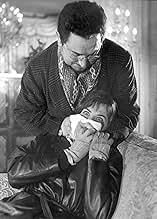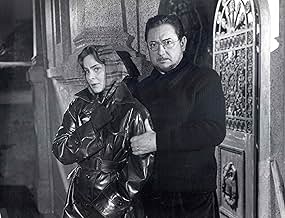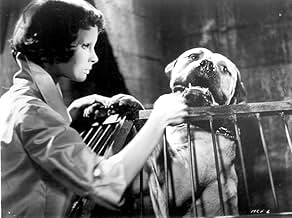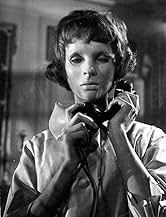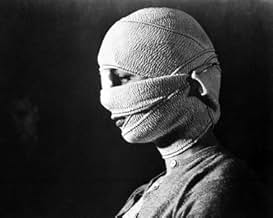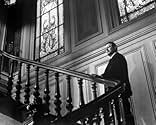NOTE IMDb
7,6/10
37 k
MA NOTE
Un chirurgien provoque un accident qui a défiguré sa fille et va jusqu'à l'extrême pour lui donner un nouveau visage.Un chirurgien provoque un accident qui a défiguré sa fille et va jusqu'à l'extrême pour lui donner un nouveau visage.Un chirurgien provoque un accident qui a défiguré sa fille et va jusqu'à l'extrême pour lui donner un nouveau visage.
- Réalisation
- Scénario
- Casting principal
Charles Blavette
- L'homme de la fourrière
- (scènes coupées)
- (as Blavette)
Charles Bayard
- Un homme à la conférence
- (non crédité)
Avis à la une
George Franju's "Yeux Sans Visage" is extremely slow yet absolutely riveting. The direction is masterful and Pierre Brasseur is superb as the dedicated doctor whose love for his daughter leads him to commit unspeakable crimes.
The cold, sinister atmosphere of the film will seep into your bones and you may find it hard to look at the screen when the central skin-removal operation takes place - this is an extraordinarily grisly sequence for its time, lent all the more power by the cold, matter-of-fact direction and acting.
In a film full of haunting images, you will find the last one unforgettable.
Why can't modern directors make horror films as good as this? It deals with a potentially lurid, gory subject-matter with masterly subtlety and skill.
The cold, sinister atmosphere of the film will seep into your bones and you may find it hard to look at the screen when the central skin-removal operation takes place - this is an extraordinarily grisly sequence for its time, lent all the more power by the cold, matter-of-fact direction and acting.
In a film full of haunting images, you will find the last one unforgettable.
Why can't modern directors make horror films as good as this? It deals with a potentially lurid, gory subject-matter with masterly subtlety and skill.
Georges Franju's atmospheric masterpiece is a tapestry of contradictions. Eyes Without a Face is a compelling tale of sadism that has an astute tenderness at the same time. A film that will disgust you with it's macabre imagery, yet simultaneously mesmerise you with it's beauty; a seething tale of love, fashioned by extreme guilt. Through the Gothic confines of a grandiose mansion, Franju has taken ideas from classic stories such as 'Frankenstein' and constructed a dream like surrealistic fantasy that has inspired legions of filmmakers since: from obvious inspirations like Jess Franco's The Awful Dr Orlof, all the way to the full blown Hollywood action fest, Face/Off; Eyes Without a Face stands out as one of cinema's most important, yet most overlooked films. The central story is a deliriously simple tale of vanity, guilt and redemption; yet one that is lent a great depth from it's cast of central characters. Doctor Génessier, guilt ridden over a car accident that left his beloved daughter, Christiane, with a destroyed face uses his assistant to kidnap young girls in an attempt to reconstruct her ruined features. The good doctor peels the faces from his victims and grafts them over the ruined features of his young daughter. However, the experiments are a continual failure but, motivated by a strong sense of guilt, Doctor Génessier must keep trying.
The doctor himself is a masterpiece of horror film villainy. Unlike many mad scientists since, the doctor here is firmly placed within reality which makes his motivations easy to believe and therefore the horror all the more fascinating. He is supported by his assistant, Louise; a fellow web of intrigue. Louise isn't the normal mad doctor's assistant; she isn't deformed, or demented but rather a cunning, malevolent and cerebral predator; gathering her victims to aid the doctor's latest experiment. The real masterpiece of characterisation, however, comes from the central character; the disfigured tragedy herself, Christiane. The scenes that see her float around in her mask gown are some of the most memorable ever brought to the screen. While wearing her mask, Christiane represents both life and death. The mask itself is stagnant and lifeless, but the eyes beneath the mask are full of life's beauty, giving the young girl a surrealistic look that epitomises the film in that it's hard to place; is it beautiful, or revolting; good or evil?
This film is a rare treat in that it's actually frightening. Eyes Without a Face taps into the viewer's fears by presenting us with a situation that is terrifying because it involves a central character living with horror. You can have all the maniacs with all the weapons you can think of; but it doesn't compare to having to go to bed every night with a face that is scarred beyond redemption. A fate worse than death, I'm sure you'll agree. This premise is given conviction through a stark and constantly foreboding atmosphere, which comes as a result of Eugen Shuftan's magnificent cinematography. The film has a crisp and clean look, which brilliantly offsets the macabre scenes that it is capturing. Thankfully, Georges Franju also seems keen to keep the focus on the surreal horror aspects of the story, which is shown by the way that he rushes through the police investigation that stems from the doctor's experiments. The film also features a striking and memorable musical score. The music sounds like it wouldn't be out of place in a carnival or circus, which fits the movie brilliantly as it covers the weird and wonderful imagery that we are treated to on screen.
Overall, Eyes Without a Face is a magnificent expression of the horror genre. The creativity and beauty of the film are sure to delight anyone who encounters it, and this is as important and as breathtaking as anything cinema has to offer. All I can say is that the word 'masterpiece' was added to the English language with this film in mind.
The doctor himself is a masterpiece of horror film villainy. Unlike many mad scientists since, the doctor here is firmly placed within reality which makes his motivations easy to believe and therefore the horror all the more fascinating. He is supported by his assistant, Louise; a fellow web of intrigue. Louise isn't the normal mad doctor's assistant; she isn't deformed, or demented but rather a cunning, malevolent and cerebral predator; gathering her victims to aid the doctor's latest experiment. The real masterpiece of characterisation, however, comes from the central character; the disfigured tragedy herself, Christiane. The scenes that see her float around in her mask gown are some of the most memorable ever brought to the screen. While wearing her mask, Christiane represents both life and death. The mask itself is stagnant and lifeless, but the eyes beneath the mask are full of life's beauty, giving the young girl a surrealistic look that epitomises the film in that it's hard to place; is it beautiful, or revolting; good or evil?
This film is a rare treat in that it's actually frightening. Eyes Without a Face taps into the viewer's fears by presenting us with a situation that is terrifying because it involves a central character living with horror. You can have all the maniacs with all the weapons you can think of; but it doesn't compare to having to go to bed every night with a face that is scarred beyond redemption. A fate worse than death, I'm sure you'll agree. This premise is given conviction through a stark and constantly foreboding atmosphere, which comes as a result of Eugen Shuftan's magnificent cinematography. The film has a crisp and clean look, which brilliantly offsets the macabre scenes that it is capturing. Thankfully, Georges Franju also seems keen to keep the focus on the surreal horror aspects of the story, which is shown by the way that he rushes through the police investigation that stems from the doctor's experiments. The film also features a striking and memorable musical score. The music sounds like it wouldn't be out of place in a carnival or circus, which fits the movie brilliantly as it covers the weird and wonderful imagery that we are treated to on screen.
Overall, Eyes Without a Face is a magnificent expression of the horror genre. The creativity and beauty of the film are sure to delight anyone who encounters it, and this is as important and as breathtaking as anything cinema has to offer. All I can say is that the word 'masterpiece' was added to the English language with this film in mind.
An early French chiller that set a benchmark in horror film making, with its unflinching depiction of horrific acts of surgery. The films sole purpose is to shock you in revealing things never before seen in 1959. Unfortunately, we are now in the age of cheap teen horror flicks and action films that feel the need to throw gore in our faces at every possible moment thus diminishing the impact of this film when watching it. Especially now we're in the 21st century, many of the scenes are comparatively tame. This does not mean, however, I disliked the film. Quite the contrary. Eyes Without A Face contains some truly terrifying images that make the hairs stand up on the back of your neck. The use of a woman in a white mask (a technique used so well in films such as Halloween and Friday the 13th) provides the films more memorable and spine tingling moments. It's the clever use of shade and light that make this possible as the director and cinematographer provide us with long -lasting images to chill to the bone.
The pace of the film is also worth a mention. Franju (the director) keeps us on the edge of our seat as the rich upper class couple lead young women into their house in order to remove their face! For some the pace could prove rather too slow - as in truth it did for me once or twice. But the payoffs from the slow pace offset any problems posed by it. It actually comes as a relief from the many directors who, in this day, believe that quick cuts and loud noise provide terror. Maybe it's time they delved back into the likes of this film, Halloween and Psycho to provide them with a few inspirations. I can think of only a handful of directors that have provided me with any real fright in the past ten years - M. Night Shyamalan (The Sixth Sense and Signs), Daniel Myrick and Eduardo Sanchez (The Blair Witch Project) and Wes Craven (Scream) are some of the few I can mention. Other films like the truly awful Jeepers Creepers and Thirteen Ghosts, which served no real purpose what-so-ever, provided me with quick cuts and loud noises - neither of which particularly endeared me to their cause. Call me an old fuddy duddy, but it's time they made more horrors like they did in the old days - films with real suspense and images which truly frighten; films like this one.
Well, that's my moan over with. I gave this film 8/10, for those that care.
The pace of the film is also worth a mention. Franju (the director) keeps us on the edge of our seat as the rich upper class couple lead young women into their house in order to remove their face! For some the pace could prove rather too slow - as in truth it did for me once or twice. But the payoffs from the slow pace offset any problems posed by it. It actually comes as a relief from the many directors who, in this day, believe that quick cuts and loud noise provide terror. Maybe it's time they delved back into the likes of this film, Halloween and Psycho to provide them with a few inspirations. I can think of only a handful of directors that have provided me with any real fright in the past ten years - M. Night Shyamalan (The Sixth Sense and Signs), Daniel Myrick and Eduardo Sanchez (The Blair Witch Project) and Wes Craven (Scream) are some of the few I can mention. Other films like the truly awful Jeepers Creepers and Thirteen Ghosts, which served no real purpose what-so-ever, provided me with quick cuts and loud noises - neither of which particularly endeared me to their cause. Call me an old fuddy duddy, but it's time they made more horrors like they did in the old days - films with real suspense and images which truly frighten; films like this one.
Well, that's my moan over with. I gave this film 8/10, for those that care.
At the time 'Les yeux sans visage' was released, the film was not very popular and faced common rejection by the critics. Regardless of those dis-affirmations, it raised to the position of a classic in the horror genre. Franju - one of the founders of the legendary Cinemathèque Française - succeeded in an intriguing way to make film history sensible as a source of inspiration of an entirely peculiar vision.
The clinic of Dr. Génessier (P. Brasseur) is located not very far from Paris. Famous as a specialist in skin grafting, nobody foreshadows that the scientific ambition of the surgeon is incident with a horrifying secret: Since an accident has destroyed the face of Génessier's daughter, Christiane (Scob), the doctor does everything to reconstruct her beauty. With the help of his assistant Louise (Valli) he clucks young women in his remote mansion, benumbs them and makes them a victim of a macabre surgical operation. In a hidden operating room in the basement of his house, Génessier removes the facial skin and transplants it on Christiane's face. Without lasting successes.
That Franjus film has not suffer losses from its immensely disturbing effects is because of, if nothing else, the camera work of Eugen Schüfftans. His brilliant black and white shots resurrects the bright dark of the expressionist German silent film. It imparts Villa Génessier a threatening life of it's own, transmutes it in a mazy horror house which seems like one can not escape. The shadows of the stairway handrails lay on everybody who enters the building like grids and makes him optically a prisoner of Génessier's delusion, mostly his daughter Christiane. Cut from a real life she haunts through the paternal ruins, the garbled face concealed behind a white porcelain mask, whose sad expression seems to nail the doom of the young woman.
Christiane's mask also points out a central principle of formation of the film: It's suspense results substantially from the interaction of visible and invisible things, of showing and dissembling. Franju subtly creates a nightmarish atmosphere that evokes the horror of Génessier's actions, but never makes it explicitly in the first instance - only to show it the viewer more pitilessly: When the surgeon unprovided cuts into the juvenilely beautiful face of one of his victims. This moment of shocking intensity reminds of the razor blade cut through the woman's eye of Bunuel's surrealistic classic 'Un chien andalou' (1929). With the same zest to provoke, Franju also presents the result of an ostensibly succeeded operation: A sober sequence of photographs shows, commented by Génessier off-stage, at first Christiane's angelically delicate face, then how the transplanted skin becomes patchy a few days later, splits open and two weeks later dies off. The cruelty of those two sequences exposes Génessier as a perverted, pestilent doctor and his paternal love as brutal obsession. The attempt to give his daughter a new face means at the same time to erase her identity, to create the ideal woman.
'Les yeux sans visage' remains in the memory of the viewer as one of the rare places on the imaginary continent, phantasmagoric and exigent with ample suspense and shocking details, a perfect alchemy of horror and allegoric poesy whereby one of the most beautiful horror films came into being.
The clinic of Dr. Génessier (P. Brasseur) is located not very far from Paris. Famous as a specialist in skin grafting, nobody foreshadows that the scientific ambition of the surgeon is incident with a horrifying secret: Since an accident has destroyed the face of Génessier's daughter, Christiane (Scob), the doctor does everything to reconstruct her beauty. With the help of his assistant Louise (Valli) he clucks young women in his remote mansion, benumbs them and makes them a victim of a macabre surgical operation. In a hidden operating room in the basement of his house, Génessier removes the facial skin and transplants it on Christiane's face. Without lasting successes.
That Franjus film has not suffer losses from its immensely disturbing effects is because of, if nothing else, the camera work of Eugen Schüfftans. His brilliant black and white shots resurrects the bright dark of the expressionist German silent film. It imparts Villa Génessier a threatening life of it's own, transmutes it in a mazy horror house which seems like one can not escape. The shadows of the stairway handrails lay on everybody who enters the building like grids and makes him optically a prisoner of Génessier's delusion, mostly his daughter Christiane. Cut from a real life she haunts through the paternal ruins, the garbled face concealed behind a white porcelain mask, whose sad expression seems to nail the doom of the young woman.
Christiane's mask also points out a central principle of formation of the film: It's suspense results substantially from the interaction of visible and invisible things, of showing and dissembling. Franju subtly creates a nightmarish atmosphere that evokes the horror of Génessier's actions, but never makes it explicitly in the first instance - only to show it the viewer more pitilessly: When the surgeon unprovided cuts into the juvenilely beautiful face of one of his victims. This moment of shocking intensity reminds of the razor blade cut through the woman's eye of Bunuel's surrealistic classic 'Un chien andalou' (1929). With the same zest to provoke, Franju also presents the result of an ostensibly succeeded operation: A sober sequence of photographs shows, commented by Génessier off-stage, at first Christiane's angelically delicate face, then how the transplanted skin becomes patchy a few days later, splits open and two weeks later dies off. The cruelty of those two sequences exposes Génessier as a perverted, pestilent doctor and his paternal love as brutal obsession. The attempt to give his daughter a new face means at the same time to erase her identity, to create the ideal woman.
'Les yeux sans visage' remains in the memory of the viewer as one of the rare places on the imaginary continent, phantasmagoric and exigent with ample suspense and shocking details, a perfect alchemy of horror and allegoric poesy whereby one of the most beautiful horror films came into being.
This film is dark and somber with a spare, eerie music score that suits perfectly the macabre, surreal story. A brilliant but deranged surgeon, having caused his daughter's disfigurement in a car accident, loses touch with reality and tries to restore her beauty in a most repulsive manner. Undeterred by failure, the mad doctor continues his gruesome work, hoping to find a miracle cure that will reconstruct the girl's facial features and also relieve him of his tremendous burden of guilt. The once-lovely girl realizes that she will never enjoy a normal life or see her beloved fiancé again, and her mute telephone calls to him just to hear his voice show how empty and lonely her life has become. There are some scenes that are horribly graphic but quite well done and a few moments that are poignant and touching amid the cruelty and butchery of the movie's central theme. Each character in this grim, unhappy feature is victimized in some fashion, but in spite of its subject matter, this cult classic is lean, first-rate storytelling.
Le saviez-vous
- AnecdotesDuring the original release of the film in the UK in 1960, an English film critic for "The Spectator" was nearly fired for writing a positive review of it after the general critical reaction to it had been negative.
- GaffesWhen she is not wearing it, Christiane's mask is very thick and heavy and would only seem to cover her face. When she puts it on, however, it is very thin, close-fitting, and seamlessly covers her jawline and the underside of her chin, revealing that the mask itself is a prop while the actress probably wears a combination of makeup and prosthetics.
- Citations
Christiane Génessier: My face frightens me. My mask frightens me even more.
- Versions alternativesThe film's original release in the U.S. in 1962 was dubbed in English, edited and re-titled "The Horror Chamber of Dr. Faustus". The surgery scene was cut for content, while any and all scenes that made Dr. Genessier seem to be sympathetic (particularly the scene where he cares for a sick boy) were also cut.
- ConnexionsFeatured in Cinéma, de notre temps: Georges Franju, le visionnaire (1996)
Meilleurs choix
Connectez-vous pour évaluer et suivre la liste de favoris afin de recevoir des recommandations personnalisées
- How long is Eyes Without a Face?Alimenté par Alexa
Détails
Box-office
- Montant brut aux États-Unis et au Canada
- 58 565 $US
- Week-end de sortie aux États-Unis et au Canada
- 19 628 $US
- 2 nov. 2003
- Montant brut mondial
- 62 793 $US
- Durée1 heure 30 minutes
- Couleur
- Rapport de forme
- 1.66 : 1
Contribuer à cette page
Suggérer une modification ou ajouter du contenu manquant

Lacune principale
By what name was Les yeux sans visage (1960) officially released in India in English?
Répondre
![Regarder Tráiler [OV]](https://m.media-amazon.com/images/M/MV5BOGQ0MzNjNTYtYTViNC00NjVjLWI2MDEtYTczMzJjMTZlZDUwXkEyXkFqcGdeQXRyYW5zY29kZS13b3JrZmxvdw@@._V1_QL75_UY281_CR0)

